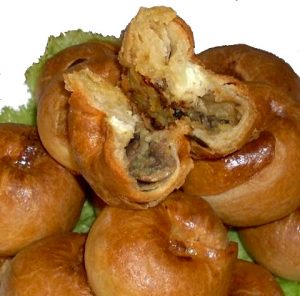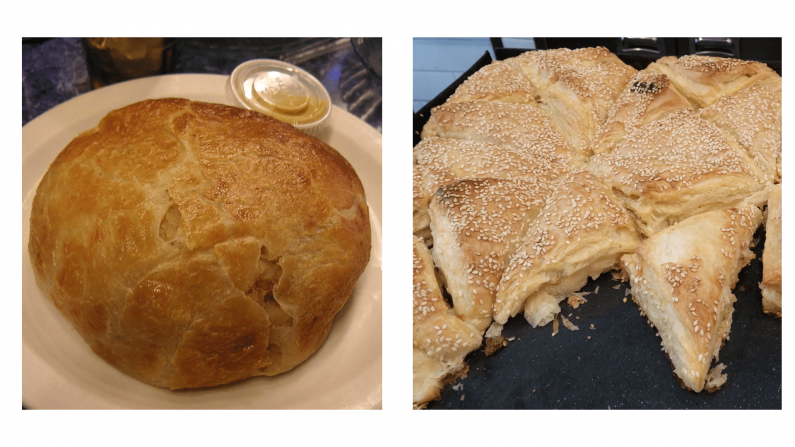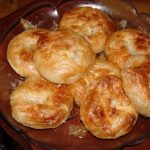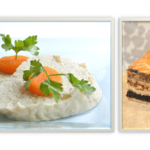Knishes are a type of beloved Ashkenazi stuffed pastry. Bourekas, as I’ve written about previously, are a type of beloved Sephardi stuffed pastry. Is there a connection between them, and if so, what is it? That is essentially what I was asked by two readers of my recent post about boyos and bulemas, though they asked it in somewhat different ways.
Robert told me of his paternal grandmother, from Russia, who made a boureka-like pastry with what he referred to as a “stretch dough,” including such fillings as potatoes and sauteed onions. He said she alternately referred to them as “cheese bagels” or “potato knishes,” but he wondered if perhaps his family originated in the Sephardic world before they arrived in Russia, based on the dish’s similarity to Sephardic bourekas. Pilar, meanwhile, simply asked me what I saw as the similarities and/or differences between boyos and knishes.
In brief, these questions highlight some of the complexities of attempting to unravel the history of foods, particularly when cooking is such a down-to-earth activity that was often ignored by scholarly writers throughout history. Thus, unraveling all of the threads of a certain food’s history and/or family tree becomes notoriously challenging.
With this post, I want to explore some of those complexities, and also answer these questions as accurately as I can.
When Does a Dish Turn Into a New One?

So at what point does a dish’s modification of a previous food turn it into a “new” food, rather than just a version of its predecessor? I don’t think there is one perfect or universal answer to this question. Rather, it is a judgment call that anyone needs to make on a case-by-case basis. That being said, when examining each example, there are numerous variables to consider:
- Main ingredients of the food
- Secondary and tertiary ingredients of the dish
- Method in which the item is prepared/cooked
- When/how the food is eaten
- The name of the dish
- Physical appearance of the food
This is not a comprehensive list, nor are these criteria of equal value, but they can help one evaluate the connections between two potentially related foods. Hypotheses should also be checked against known history, and the plausibility of one food developing into another; if you believe that “food A” is the gastronomic parent of “food B,” you must not only show the similarities within many of the above variables, but you must also explain how that culinary transmission from A to B took place.
So What About Knishes and Bourekas?

Is it possible that any two of them might have actually grown out of the same evolutionary chain? Of course! But it seems fairly unlikely that any one is a direct antecedent of any of the others. In most cases, we are probably looking at what we’d call parallel developments — people in difference parts of the world coming up with similar ideas on their own, rather than one directly drawing from each other.
So to answer Pilar’s question first, while the similarities between these Ashkenazi and Sephardi foods exist, there are many more differences. The names seem unrelated, for starters. This is not always the case. For example, one way we identify the culinary predecessor of samosas is based on the linguistic similarities (along with the gastronomic ones) to the Middle Eastern sambusak.
The dough in knishes and bourekas (the original ones more than the later alteration into puff pastry or filo) are moderately similar, though certainly not identical, but the classic fillings vary. While potato/onion is popular in both, it would be very surprising to find kasha bourekas or pumpkin knishes!
Finally, I think one of the main differences between them is the reason and way in which they were prepared and eaten. Knishes were designed as a way to repurpose and extend leftovers, encasing them in an “edible tupperware.” The Sephardic pastries, meanwhile, typically utilized made-from-scratch fillings.
Which also brings us to Robert’s question. It is somewhat hard for me to evaluate how similar his grandmother’s knishes were to potential Sephardic precursors without seeing/tasting them and looking carefully at the dough involved. But it appears improbable that hers were the direct descendants of bourekas. While there were undoubtedly small numbers of Sephardic Jews who made their way to the Russian territories, historically speaking they were a tiny drop in the population bucket. To find a Russian Jew of Sephardic descent would be extremely rare. And the prior existence of knishes in that territory suggests her pastries were simply the “children” of other knishes, if they were indeed unique in some manner.
That being said, anything is possible! But a DNA test would better clarify whether Robert’s roots were in Spain or not. Whichever is the truth, however, nothing prevents him — and all of us — from enjoying both knishes and bourekas equally!







Ashkenazi Food: Unrecognized Diversity
[…] more of a staple dish in Poland, along with other frugal Ashkenazi foods such as gefilte fish and knishes. And the famous yeast cake known as babka originated here, or perhaps in Russia […]